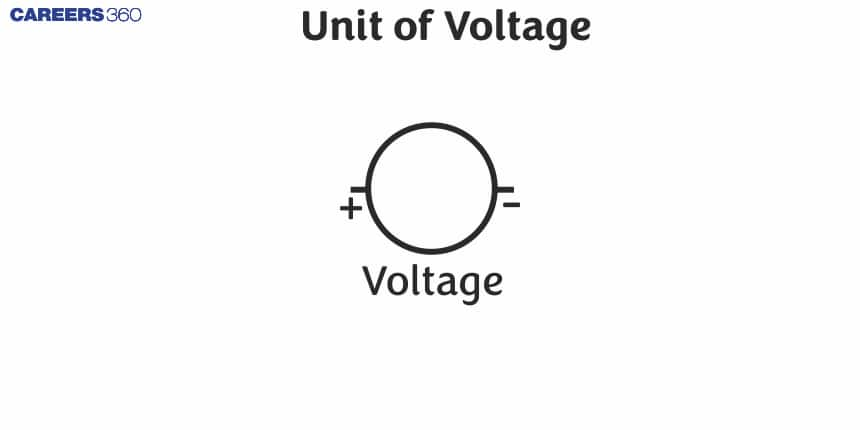Unit of Voltage
In this article, we are going to learn about the volt uses, volt definition, voltage definition and voltage meaning, voltage units, 1 unit ml volt meaning by answering the questions such as what is voltage, what is SI unit of voltage, what is voltage source, what is the voltage symbol and so on to get a better understanding about the unit of voltage.
New: JEE Main/NEET 2027 - Physics Important Formulas for Class 10
JEE Main 2025: Study Materials | High Scoring Topics | Preparation Guide
JEE Main 2025: Syllabus | Sample Papers | Mock Tests | PYQs | Study Plan 100 Days
NEET 2025: Syllabus | High Scoring Topics | PYQs | Crack NEET in 2 months - Study Plan

Voltage is defined as the pressure or the potential of the circuit that pushes the flow of electrons and produces the current flow in the circuit. The SI unit of voltage is volts. A Volt is known as the unit of the potential or potential difference. It is one of the units in the Standard unit system. When a conductor carries one unit of ampere current and power is equal to one watt, then the potential difference between the two endpoints of the conductor is one volt. The term “volt” is named after the Italian Physicist Volta. According to ohm's law, voltage is equal to the current I multiply by resistance R. The volt can be written in terms of SI base units kgm2s-3A-1.

Also read -
- NCERT Solutions for Class 11 Physics
- NCERT Solutions for Class 12 Physics
- NCERT Solutions for All Subjects
The voltage can be mathematically expressed by the following formula
V = IR, where V denotes the potential, I denotes the current and R denotes resistance
Here, the unit of potential is given in Volts, unit of current is given in ampere, unit of resistance is given in ohm.
The unit of voltage is expressed as volts and the symbol of the voltage expression is given as “V”. Volt is also the SI unit of electromotive force.
The volt definition can be given in terms of watt and ampere i.e. in the units of power and current. It is defined to be the potential along the wire when one unit of ampere current can dissipate one unit of watt power. This can be mathematically expressed by the upcoming formula, V= W/A. where, V stands for voltage, W stands for watt power, A stands for ampere current.
The volt expression can be also given in the terms of joule and coulomb i.e in the units of energy and charge. One volt can be defined as the potential difference between the points which impart one unit of joule energy per one unit of coulomb charge which flows in the electric circuit. The mathematical expression of the definition is given as, V=J/C, where, V denotes the voltage, J for joule energy, C stands for coulomb charge.
Let us now see some other expressions of volt.
V=A=Wb/s
Related Topics Link, |
History of volt
In the year 18 hundreds, Volta invented the voltaic pile to disagree with the galvanic response given by the Galvani. The voltaic pile is known as the forerunner of the battery cell. In the year of 1861, the two scientists Latimer Clark and Charles Bright gave the unit volt for resistance at first. Later in the year of 1873 i.e. after 12 years, the British Association for the Advancement of Science gave the definition for volt, ohm and farad. And in the year of 1881, IEC (International electrotechnical commision) gave the approval for the volt and declared it as the unit of emf (electromotive force). In conventional , the volt is defined in the year of 1987, in the 18th meeting of the general conference on weights and measures. The term volts got into practice from the year of 1990. In the Josephson effect, the term volt was implemented for the exact conversion of frequency and voltage which is combined with the Caesium frequency standard. The definition of “international volt” is given as 1/1.434 of electromotive force of the clark cell in the year of 1893.
Read:
- NCERT solutions for Class 12 Physics Chapter 3 Current Electricity
- NCERT Exemplar Class 12 Physics Solutions Chapter 3 Current Electricity
- NCERT notes Class 12 Physics Chapter 3 Current Electricity
Definition of voltage source
A definition of voltage source is given as the device or instrument that can be used in electric circuits of which their potential difference at ends are fixed. It can be either battery or some other source whose potential difference and the current is fixed.
The voltage source acts as the component of the closed circuit and that source should be capable of producing EMF (electromotive force). Thus the EMF and voltage share the same unit, volt.
Ideal sources are the sources which do not have any internal resistance. But in practice, the real sources are not ideal. For example, a battery is an example for a real source and not for ideal sources as it contains some internal resistance in it. Voltage takes the pressurised form of a charged power source which is used to push the electrons.
From this article, we learnt the definition of voltage, unit of voltage, symbol and expressions of volt in different terms. Now, let us see some frequently asked questions from class 10, class 11 and class 12.
Also check-
- NCERT Exemplar Class 11th Physics Solutions
- NCERT Exemplar Class 12th Physics Solutions
- NCERT Exemplar Solutions for All Subjects
NCERT Physics Notes:
Frequently Asked Questions (FAQs)
Volt is known as the unit of the potential or potential difference. The voltage is measured in volts. The unit of voltage is expressed as volts and the symbol of the voltage expression is given as “V”. Volt is also the SI unit of electromotive force.
Voltage is defined as the pressure or the potential of the circuit that pushes the flow of electrons and produces the current flow in the circuit.
The voltage unit is given in terms of volt and the symbol of the volt is V. The volt can be written in terms of SI base units kgm2s-3A-1.
Ideal sources are the sources which do not have any internal resistance. But in practice, the real sources are not ideal. For example, a battery is an example for a real source and not for ideal sources as it contains some internal resistance in it.
The voltage can be mathematically expressed by the following formula:
V = IR, where V denotes the potential, I denotes the current and R denotes resistance
Here, the unit of potential is given in Volts, unit of current is given in ampere, unit of resistance is given in ohm.
The volt definition can be given in terms of watt and ampere i.e. in the units of power and current. It is defined to be the potential along the wire when one unit of ampere current can dissipate one unit of watt power. This can be mathematically expressed by the upcoming formula, V= W/A. where, V stands for voltage, W stands for watt power, A stands for ampere current.
The volt expression can be also given in the terms of joule and coulomb i.e in the units of energy and charge. One volt can be defined as the potential difference between the points which impart one unit of joule energy per one unit of coulomb charge which flows in the electric circuit. The mathematical expression of the definition is given as, V=J/C, where, V denotes the voltage, J for joule energy, C stands for coulomb charge.
Also Read
29 Nov'24 09:48 AM
23 Nov'24 01:56 PM
20 Nov'24 10:32 AM
17 Nov'24 10:02 AM
17 Nov'24 09:56 AM
14 Nov'24 07:31 PM
14 Nov'24 05:59 PM
14 Nov'24 01:16 PM
14 Nov'24 12:54 PM